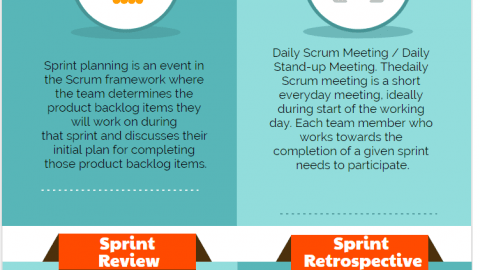Sprint Planning Meeting – Best Practices
Did you participate in a sprint planning meeting before starting a new sprint? Sprint planning is a short working session that takes approximately 2 hours for every week of a sprint. This means for a three-week sprint, the meeting takes roughly 6 hours. In general, you can determine the duration of sprint planning by multiplying the number of weeks in your sprint by two hours. No matter how long they take, all the meetings do not provide a roadmap for the team if they are not assembled in an efficient way. However, the aim of this meeting is to help the team to create good work. In this article, we will discuss how to run a sprint planning meeting and list the benefits of this important meeting. After reading this article, you will gain more knowledge on the subject. Before starting, let’s discuss the definition of the agile sprint planning meeting.
Table of Contents
What is a Sprint Planning Meeting?
The sprint planning meeting is one of the most important scrum ceremonies to achieve agile implementation within an organization. Therefore implementing agile and planning successful meetings require skilled and experienced team members. It is a kickoff meeting for each sprint to assembled to answer the questions, What will be delivered in this next sprint? How will we deliver?
Simply put, the scrum master and the entire scrum team discuss the structure, set expectations, and define the backlog for the next sprint by answering these questions in a sprint planning meeting.
During a sprint planning meeting, the product owner describes the priorities for the product and the scrum team asks questions to understand the key aspects. It is a collaborative meeting in which the product owner, the scrum team, and in some cases outside stakeholders may attend in.
At the end of the meeting, the team will have the following;
- The Sprint Backlog: The list of tasks to be completed during Scrum Sprint
- The Sprint Goal: Defines what can be delivered during the sprint
- Agreement by the team to do what is possible to achieve the goals.
For better understanding let’s discuss each role in a scrum team.
Scrum Roles
Agile is one of the most common project management methodologies which is applicable to almost every industry project from software development to manufacturing. Many people think that scrum is a methodology like agile. However, this is not true. Scrum is one of the most applicable frameworks to implement agile which allows team members to resolve complex adaptive problems while delivering products.
Basically, Scrum roles differ from traditional project management roles. There are 3 major scrum roles which are the product owner, the scrum master, and the development team.
Scrum Master
Scrum Master is a person who guides the project team and makes sure that the process is following the Scrum framework. He or she improves the productivity of the team by removing the obstacles and organizing the critical meetings. From this aspect, he acts as a protector which makes the process run smoothly.
From the sprint planning meeting point of view, he/she facilitates the meeting and ensures that members are prepared and every participant is available at the scheduled time.
Product Owner
The product owner is the one who is responsible for expressing the product backlog items to the team members. His/Her aim is to maximize the value of the product. In other words, one of the main responsibilities of a product owner is to order and prioritize the Product Backlog items to goals and missions.
The product owner should be well prepared before the sprint planning meeting in terms of creating the product backlog items. Because he/she will answer the questions of the team around product requirements such as acceptance criteria.
The Development Team
The development team is a group of experts (designers, developers, testers, etc.) who will do the actual work or contribute to the product. The product owner sets product backlog items, the scrum master guides the team to follow the Scrum framework and the development team performs the work.
What is expected from the development team in a sprint planning meeting?
- Actively participating in the meeting
- Having a clear understanding of the requirements
- Collaboration and coordination
Why Run a Sprint Planning Meeting?
Working like an organized team often brings more success than working as unorganized individuals. This meeting provides a great opportunity to get the scrum team together and remind the responsibility of each participant over the next sprint. Without a meeting, it is difficult to understand what exactly team members are working on and who is responsible for what.
Benefits of Running a Sprint Planning Meeting
Running a sprint planning meeting provides many benefits to the organizations while implementing the Agile Project Management Methodology. Below are some of them,
- Improves communication, collaboration, and teamwork
- Provides a better understanding of the requirements of the product
- Better task prioritization and estimation
- Provides different approaches and point of views
- Ensures delivering products with the highest possible value
- Improves Just In Time (JIT) planning
- Provides a reference point for velocity measurement
- Provides a better definition of the goals (Sprint Goal and Sprint Backlog definition)
Tips for Running an Effective Sprint Planning Meeting
If the meeting is assembled correctly, you will get a chance to improve the efficiency of the team.
- Hold a pre-meeting before the meeting
- Set the goal of the sprint and prioritize the stories
- Create a Meeting Agenda to save time.
- Remind the goals or visions of the project to the team members.
- Know the capacity of the team and the team members
- Keep the length of the meeting optimum.
- Present product backlog items
- Discuss new information and updates that may affect the plan
- Present the velocity to be used
- Learn from the mistakes
Summary
Every project manager knows some practices and methodologies. In other words, project management is on the mind of every manager. However agile is an iterative methodology for planning and guiding the project process which is applicable to almost every industry project. As we mentioned above, Scrum is one of the most applicable frameworks to implement agile. Basically, running a sprint planning meeting and implementing Agile Methodology is not difficult. However, they require experience and practices for a successful implementation.
You can share your knowledge and experiences which others can benefit through the comments box below.
See Also
External References

Margaret Conte has been working as a consultany for over 15 years. In this time, she has worked in a variety of project management methodologies (waterfall/scrum/agile) and has been a strategic Project Manager, Coordinator, Facilitator and Scrum Master. She is the co-founder of Development Fast Academy










